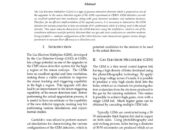The pursuit of knowledge in optics can be likened to an intricate dance, where each step reveals a facet of light’s enigmatic behavior. Self-studying optics through a seminal text such as “Optics” by Eugene Hecht presents a unique opportunity to engage with the fundamental principles of this branch of physics. This article delineates a comprehensive approach to mastering this discipline, balancing theoretical understanding with practical applications.
1. Establishing a Solid Foundation
ADS
Before delving into the complexities of Hecht’s work, it is imperative to construct a sturdy framework of prerequisite knowledge. Familiarity with basic physics concepts, particularly in mechanics and electromagnetism, serves as the bedrock for understanding optics. A solid grasp of these principles is akin to learning the scales before mastering a concerto; they provide the essential tools for navigating more sophisticated concepts. It is advisable to revisit foundational topics such as wave phenomena, reflection, and refraction, as they are pivotal in unraveling optical intricacies.
2. Navigating the Text: Analyzing the Structure
As you embark on this intellectual journey, it is prudent to consider the flow of topics. For instance, beginning with the fundamentals of geometric optics, including the laws of reflection and refraction, lays a crucial foundation. Incrementally advancing to more elaborate topics, such as interference and diffraction, enhances comprehension through context. This structured approach mirrors the construction of a building; neglecting the foundational layers may compromise the entire structure.
3. Engaging with Supplemental Resources
Moreover, engaging with hands-on experiments is invaluable. Constructing a simple optical bench to experiment with lenses, mirrors, and light sources cultivates a practical understanding of the theories discussed in the text. This empirical approach fosters a more profound appreciation of optical phenomena, thereby cementing theoretical knowledge through tangible experience.
4. Developing a Methodical Study Routine
Incorporating short intervals of rest can enhance cognitive processing and retention. Techniques such as the Pomodoro Technique can facilitate this, allowing for periods of concentrated study followed by brief respites. This cyclical pattern of study mirrors the principles of light itself—constantly in motion, yet providing clarity in bursts.
5. Applying Mathematical Rigor
Engaging with problem sets at the end of each chapter can bolster numerical fluency and enhance analytical prowess. Seeking out additional problem-solving resources or study groups can further stimulate intellectual discourse, which often elucidates nuanced concepts.
6. Assessing Progress and Reflecting
7. Embracing the Beauty of Optics
In conclusion, self-studying optics through a text such as Hecht’s requires diligence, strategic planning, and a genuine enthusiasm for discovery. By establishing a solid foundation, leveraging supplemental resources, fostering an active learning environment, and incorporating mathematical rigor, one can navigate the complexities of the optical world. Embrace the journey, for in understanding optics, one unveils not only the mechanics of light but also the very nature of our reality.
Post Views: 66










